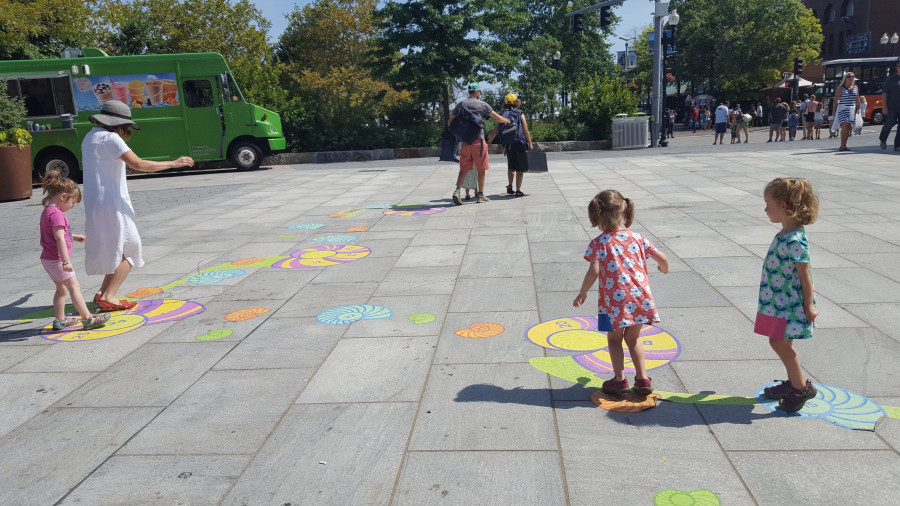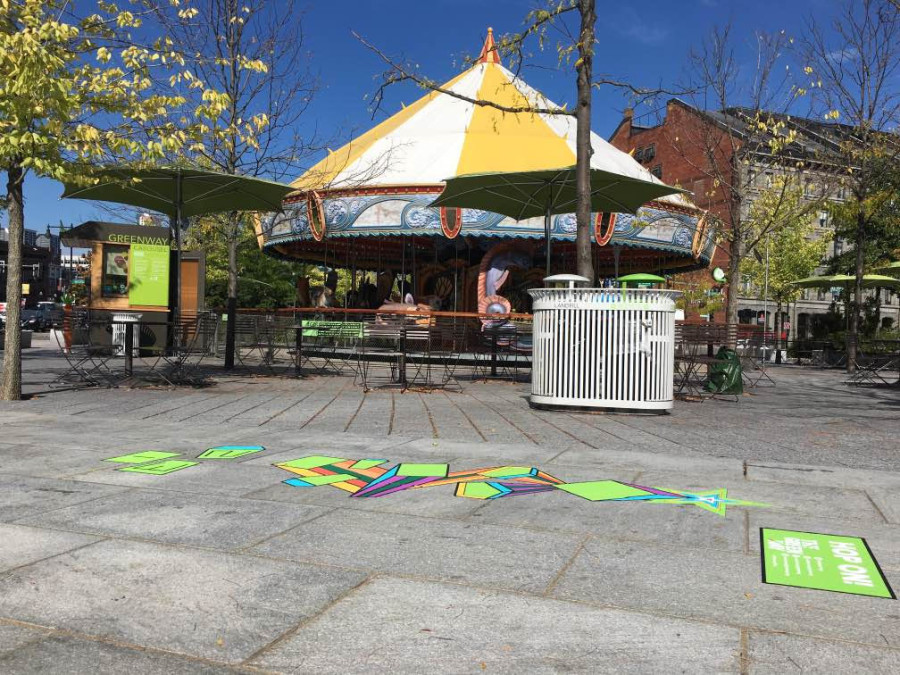Play Ambassador, Ponnapa: a playful designer and volunteer
Written by Kait Ziskin Levesque, Programs Manager
The Greenway Conservancy has spent the last few years experimenting with a durable but removable vinyl to add playful pop-ups and signage throughout park. As part of our commitment to providing playful spaces and activities, several of these experiments have been unique and imaginative hopscotches! These were designed by one of our very own Play Ambassadors, Ponnapa. In her third year as a Play Ambassador, Ponnapa spends a lot of time volunteering in Chinatown Park for Thursday night’s Play Sessions as well as throughout The Greenway for pop-up play. As a professional designer with Sasaki, we knew exactly who to turn to when we became interested in adding a temporary hopscotch board near the Greenway Carousel. Several years later, we’ve now done two hopscotchs at the Carousel and repeated one of these in Chinatown Park. Read below for more background on this new play experience and peek into the brain of our awesome Play Ambassador and her process.
Tell us a little bit about yourself and how you came to volunteer with The Greenway:
My name is Ponnapa Prakkamakul. I have a keen interest in how the design of an outdoor open space impacts the holistic development of a child. In 2013, I took a sabbatical year to be a volunteer teacher and observe how children play in a natural setting in a school at a border between Thailand and Burma. In 2015, with a grant from Sasaki I teamed up with my colleague Kate Tooke to research innovative playscapes. I also teach a class, Make Your Own Playground, for the ESP program at MIT every summer.
In 2016, I had the opportunity to present our research project at the Play Coalition Conference at Clemson University. That was where I met Kait Ziskin Levesque, Programs Manager at the Greenway Conservancy, and learned about play programming on The Greenway and the Play Ambassador role.
What do you do for a day job?
I am a landscape architect working at Sasaki in Watertown. The projects I work on mostly are large-scale master planning and urban design that serve large group of users and the public. I am working with a team of planners, urban designers, ecologists, and architects.
Tell us about the process of designing a hopscotch, what is your process?
For the Playful Perspective Hopscotch installed in 2017, I did a full scale mockup test during one of the Downtown Playdates on The Greenway. The design was improvised on site, using neon gaffer tape. It was very exciting for me to see how children of different ages played the game in different ways, and how their parents introduced them to the game. The prototype design was then revised to adjust hopping dimensions and eventually translated into a scaled computer drawing that can be printed.
For Game of Snail, installed in 2018, I started the design with thumbnail sketches first and then scanned them into computer to refine the line work and coloring. It was quite challenging to design this game, as the emphasis was on creating something that worked well across generations, and became a space instead of an outline on the ground. Therefore, the game needed to be large and challenging enough for older generations, but still not too difficult for the younger ones. I was not satisfied with the design until I printed out a full-scale mockup that I could lay out, cut apart, and reshuffle.
Can you tell us about this snail you chose? Is it from your imagination or a real snail?
The design of the snail shell was inspired by a nocturnal New England Whitelip snail, Neohelix albolabris. It is the largest land snail commonly found in the Northeastern United States. However, people rarely see them as they are hiding beneath leaf-litter during the day time. In Game of Snail, the starting point begins with brownish snail shells representing the real color of Whitelip snail’s shell.
What is the toughest part about designing play tools for children?
The difficult parts are how to understand children’s dimensions, perceptions, and preferences. Unlike adults, children have a wider range of dimensions to be considered, according to different ages. The dimensions that form their personal spaces also affect how they perceive spaces and their surrounding environment. I personally believe that playing together is best. However, it is a challenge to create a design that can accommodate such a broad ranges of dimensions and offer a fun play experience for everyone.
In my opinion, the best way to design for children is to include them into the design process. This also helps to understand their preferences, as sometimes they do not quite know what they want or like. A close observation and a mockup test are very helpful processes I use when designing play tools for children. Therefore, being a volunteer at the Greenway Conservancy has greatly informed my practice as a designer.
What is your dream project?
I would like to design and build a playground together with children and the community. The playground will have loose parts that children can continue to construct their play spaces creating a playground that evolves over time.
